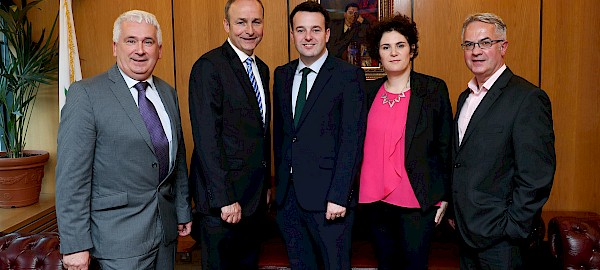
SDLP leader Colum Eastwood, Claire Hanna and Alex Attwood meeting Micheal Martin TD and Brendan Howlin TD in 2016
The Irish Times says that it has been told by senior sources from the two parties the alignment would result in “one all-island party which will be called Fianna Fáil”.
The paper’s Northern Editor Gerry Moriarty says that the final stage of negotiations are still ongoing.
But he adds that a “significant” announcement is expected to happen early in 2019, possibly as early as next month, said sources from Fianna Fáil and the SDLP.
The SDLP’s leader and Foyle MLA Colum Eastwood and Fianna Fáil leader Micheál Martin have been keeping the detail secret from most of their own party members, says The Irish Times report.
Others central to the negotiations are Fianna Fáil Donegal TD Charlie McConalogue and party general secretary Sean Dorgan, and for the SDLP deputy leader Nichola Mallon.
One source quoted by Moriarty said the parties are expected to engage in a “narrative” of announcements, with details released on an incremental basis leading up to the Fianna Fáil ardfheis in Dublin on February 23rd, where Mr Eastwood and Ms Mallon “would get a big show”.
Sources told the newspaper that the plan also was to portray the new alignment as being “bigger than simply the SDLP and Fianna Fáil”.
It was hoped to “unveil new faces from business, culture, the arts, agriculture, and from other parts of civic society” as members of the new grouping, some of whom would be future candidates in the North.
The first stage of the union is likely to be the parties setting up joint procedures to agree all-island policies, said the sources.
It is yet to be decided how the two parties will approach the first electoral test in Northern Ireland, the local elections in May.
One well-placed figure told The Irish Times that it might be too early for candidates to run on a joint platform, and it might be a case of “SDLP candidates standing with the endorsement of Fianna Fail” although that issue is not yet fully resolved.
He said both parties were aware of the risks, particularly should the SDLP perform poorly against Sinn Féin in May, which would be viewed as a boost for Sinn Féin in advance of the next general election in the Republic.
Sources said there was “overwhelming” backing within the SDLP parliamentary party for the merger, and that the Fianna Fáil parliamentary party equally was in favour. T
They said that an important part of the negotiations was devising an alliance that “maintained the legacy of the SDLP”.
A senior Fianna Fáil figure told Moriarty that ultimately the two parties would merge under the Fianna Fáil standard.
“The timescale for full integration is still being worked on; there is no clear timeline for that yet,” one source is quoted as saying.
There has been a steady decline in the fortunes of the SDLP over the past 20 years. In the Assembly elections after the 1998 Belfast Agreement the SDLP won 24 seats compared to Sinn Féin’s 18.
In last year’s Assembly elections Sinn Féin won 27 seats, while the SDLP won 12.
In 1998 the SDLP had three MP, while Sinn Féin had two.
Now Sinn Féin has seven MPs and the SDLP has none.
The biggest shock for the SDLP came when Sinn Fein’s Elisha McCallion unseated Mark Durkan in the Westminster election in June 2017.
Foyle had been a rock solid Westminster seat for Foyle for the SDLP for over three decades.
Party founder John Hume held it from 1983 until 2005 when Mark Durkan retained it for a further 12 years until Mrs McCallion, a former Mayor of Derry, was elected Foyle MP with a 189 majority.Mi
Tags:




